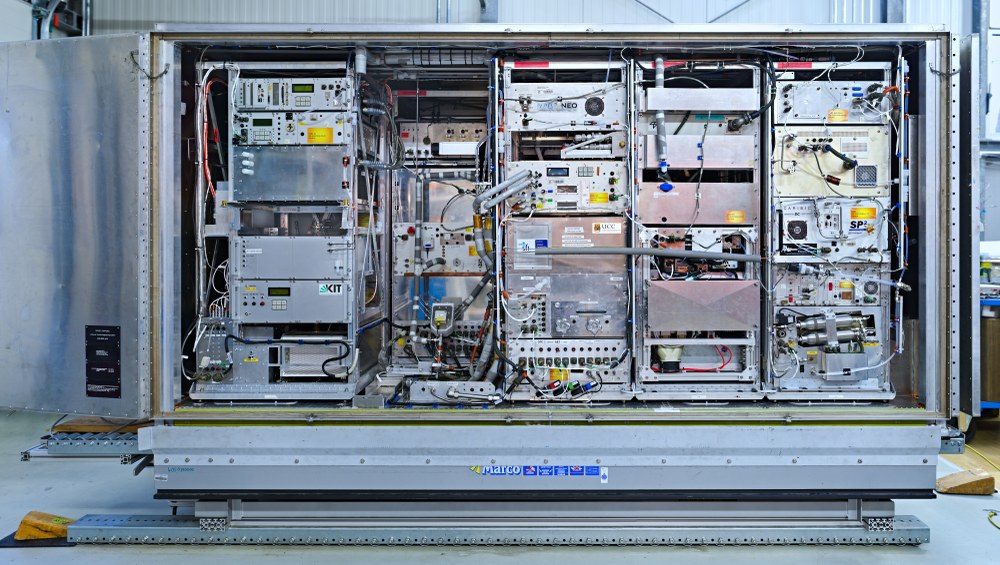Flying laboratories

Deutsche Lufthansa
The United Nations is gearing up for the Climate Change Conference (COP 29) this November with the aim of advancing climate protection. A good data basis is a prerequisite for understanding climate change and developing measures. IAGOS is a research platform that provides data on atmospheric composition at an altitude of 12,000 metres. The DLR Institute of Atmospheric Physics is contributing by measuring nitrogen oxides. DLR Projektträger has made this project fly.
Passenger aircraft like the Airbus A330 fly around the globe between the troposphere (the lowest layer of Earth's atmosphere) and lower stratosphere (the next layer up). This altitude range is particularly important for scientific research, as the concentration of nitrogen oxides, water vapour, carbon dioxide, methane, ozone and aerosol particles are important drivers of climate change. For a long time, we did not have a clear picture of the composition of the atmosphere and how it changes at this altitude. This is where the In-service Aircraft for a Global Observing System (IAGOS) research platform comes in. Ten Airbus A330 aircraft are equipped with instruments that are collecting data on every flight, which can be used to better estimate changes in the global climate.
Until the start of operations in 2022, DLR Projektträger managed the project on behalf of the German Federal Ministry of Education and Research (BMBF). By collaborating with many stakeholders from science and industry, a cost-effective method was developed to continuously observe the air at flight altitudes and measure its components. Constructing and operating a research aircraft would have been significantly more expensive. The atmospheric data acquired is made available to the global scientific community free of charge and for the long term.
Passenger aircraft at the service of scientific research

KIT/F. Obersteiner
As part of IAGOS-CORE, measurements are carried out permanently with ten passenger aircraft. Housed in a special rack below the aircraft flight decks are instrument packages that analyse the air, store the data and send it to the IAGOS and Copernicus databases. In this way, the information is available to researchers just a few hours after an aircraft lands. IAGOS is being used to carry out a long series of observations on the composition of the atmosphere.
As part of IAGOS-CARIBIC, a large air freight container in the cargo hold of a passenger aircraft is being fitted with measuring instruments. A Lufthansa A350 is being converted for a new generation of the measurement container equipped with significantly more and more precise measuring instruments, which will further improve our understanding of the atmosphere.
An important addition to satellite-based measurements
"The data collected by the IAGOS aircraft is essential for climate research, given the scarcity of direct data from other routine measurements for this altitude region. There is a lot we do not know about the atmosphere above the oceans because measurements here are only possible to a limited extent. Even satellites are unable to provide sufficiently detailed altitude-resolved measurements of the atmospheric composition in these areas," says Jochen Elberskirch, Project Manager at DLR Projektträger. "The first airborne measurements were carried out in the 1990s. Together with the current IAGOS data, they form the basis for more than 400 scientific articles, including in the scientific journals Nature and Science. This new data marks a real step forward in scientific research."

IAGOS-AISBL
Global collaboration
The international research project has been made possible thanks to the cooperation between many research institutions, airlines and the aircraft manufacturer Airbus. In Germany, Forschungszentrum Jülich is coordinating the fleet of ten passenger aircraft, whilst the Karlsruhe Institute of Technology is in charge of the measurement container project IAGOS-CARIBIC. The DLR Institute of Atmospheric Physics is contributing to the latter by measuring nitrogen oxides. An important source of these trace gases, which contribute to climate change, is aviation. In addition to the eight IAGOS member institutions, a further six research institutions from a total of five countries are involved – as well as eight airlines, which are covering part of the costs by carrying the measuring instruments aboard their aircraft.
DLR Projektträger oversees construction funding
The BMBF decided to provide financial support for the IAGOS infrastructure based on strategic advice from DLR Projektträger. Since 2012, DLR Projektträger has been responsible for coordinating the construction funding and has set up an exemplary research infrastructure with a total of 18.5 million euros from BMBF. The IAGOS laboratories now fly regularly on global itineraries, with data being continuously collected and fed into climate models. In this way, IAGOS is improving our understanding of the global climate and how it is changing. Since July 2022, the project has been coordinated by the non-profit organisation 'IAGOS-AISBL'.

An article by Lovis Krüger and Britta Paul from the DLRmagazine 175
